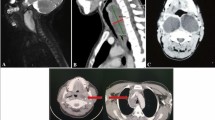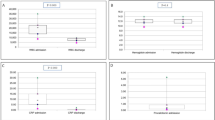Abstract
To study the circumstances of diagnosis, predisposing factors, bacteriology and therapeutic management of parapharyngeal abscesses. This retrospective study over a period of 7 years concerned 16 patients hospitalized in an ENT and Head and Neck surgery department for parapharyngeal abscess. All patients were treated by intravenous antibiotics and steroids for 5–7 days. The length of hospital stay was 6–15 days. Parapharyngeal abscesses associated with peritonsillar and retropharyngeal abscess were all initially aspirated transorally for evacuation and bacteriologic examination. Five patients underwent surgical drainage (two via cervical incision, three by immediate tonsillectomy techniques and one by intra-oral drainage). Two patients presented jugular vein thrombosis. No life-threatening complication was observed. Patients were considered to be cured when cervical CT scan performed on D21-45 was normal. Parapharyngeal abscess is the second most common deep neck abscess after peritonsillar abscess. The diagnosis is both clinical and radiologic. CT scan is the best imaging examination for diagnosis and follow-up of parapharyngeal abscess. Non-complicated parapharyngeal abscesses require first-line medical management (intravenous antibiotics (amoxicillin and clavulanic acid) combined with steroids) and follow-up CT scan.



Similar content being viewed by others
References
Amar YG, Manoukian JJ (2004) Intraoral drainage: recommended as the initial approach for the treatment of parapharyngeal abscesses. Otolaryngol Head Neck Surg 130:676–680
Gidley PW, Ghorayeb BY, Stiernberg CM (1997) Contemporary management of deep neck space infections. Otolaryngol Head Neck Surg 116:16–22
Brook I (2004) Microbiology and management of peritonsillar, retropharyngeal, and parapharyngeal abscesses. J Oral Maxillofac Surg 62:1545–1550
Kieff DA, Bhattacharyya N, Siegel NS, Salman SD (1999) Selection of antibiotics after incision and drainage of peritonsillar abscesses. Otolaryngol Head Neck Surg 120(1):57–61
Ozbek C, Aygenc E, Tuna EU, Selcuk A, Ozdem C (2004) Use of steroids in the treatment of peritonsillar abscess. J Laryngol Otol 118(6):439–442
Windfuhr JP, Chen YS (2001) Immediate abscess tonsillectomy. A safe procedure? Auris Nasus Larynx 28(4):323–327
Koivunen P, Lopponen H (1999) Internal carotid artery thrombosis and Horner’s syndrome as complications of parapharyngeal abscess. Otolaryngol Head Neck Surg 121:160–162
Sethi DS, Stanley RE (1991) Parapharyngeal abscesses. J Laryngol Otol 105:1025–1030
Duque CS, Guerra L, Roy S (2007) Use of intraoperative ultrasound for localizing difficult parapharyngeal space abscesses in children. Int J Pediatr Otorhinolaryngol 71:375–378
Shin JH, Lee HK, Kim SY, Choi CG, Suh DC (2001) Imaging of parapharyngeal space lesions: focus on the prestyloid compartment. AJR Am J Roentgenol 177:1465–1470
Eliashar R Sichel JY,Attal P, Hocwald E (2006) Redefining parapharyngeal space infections. Ann Otol Rhinol Laryngol 115:117–123
Daya H, Lo S, Papsin BC, Zachariasova A, Murray H, Pirie J, Laughlin S, Blaser S (2005) Retropharyngeal and parapharyngeal infections in children: the Toronto experience. Int J Pediatr Otorhinolaryngol 69:81–86
Alaani A, Griffiths H, Minhas SS, Olliff J, Lee AB (2005) Parapharyngeal abscess: diagnosis, complications and management in adults. Eur Arch Otorhinolaryngol 262:345–350
Holt GR, McManus K, Newman R, Potter JL, Tinsley PP (1982) Computed tomography in the di agnosis of deep-neck infections. Arch Otolaryngol 108:693–696
Giyanani VL, Mirfakhraee M, Gerlock AJ, Meyers PC (1985) Computed tomography of internal jugular thrombosis. J Comput Assist Tomogr 9:33–37
Oh JH, Kim Y, Kim CH (2007) Parapharyngeal abscess: comprehensive management protocol. ORL J Otorhinolaryngol Relat Spec 69:37–42
McClay JE, Murray AD, Booth T (2003) Intravenous antibiotic therapy for deep neck abscesses defined by computed tomography. Arch Otolaryngol Head Neck Surg 129:1207–1212
Sichel JY, Dano I, Hocwald E, Biron A, Eliashar R (2002) Non surgical management of parapharyngeal space infections: a prospective study. Laryngoscope 112:906–910
Author information
Authors and Affiliations
Corresponding author
Rights and permissions
About this article
Cite this article
Page, C., Biet, A., Zaatar, R. et al. Parapharyngeal abscess: diagnosis and treatment. Eur Arch Otorhinolaryngol 265, 681–686 (2008). https://doi.org/10.1007/s00405-007-0524-5
Received:
Accepted:
Published:
Issue Date:
DOI: https://doi.org/10.1007/s00405-007-0524-5




